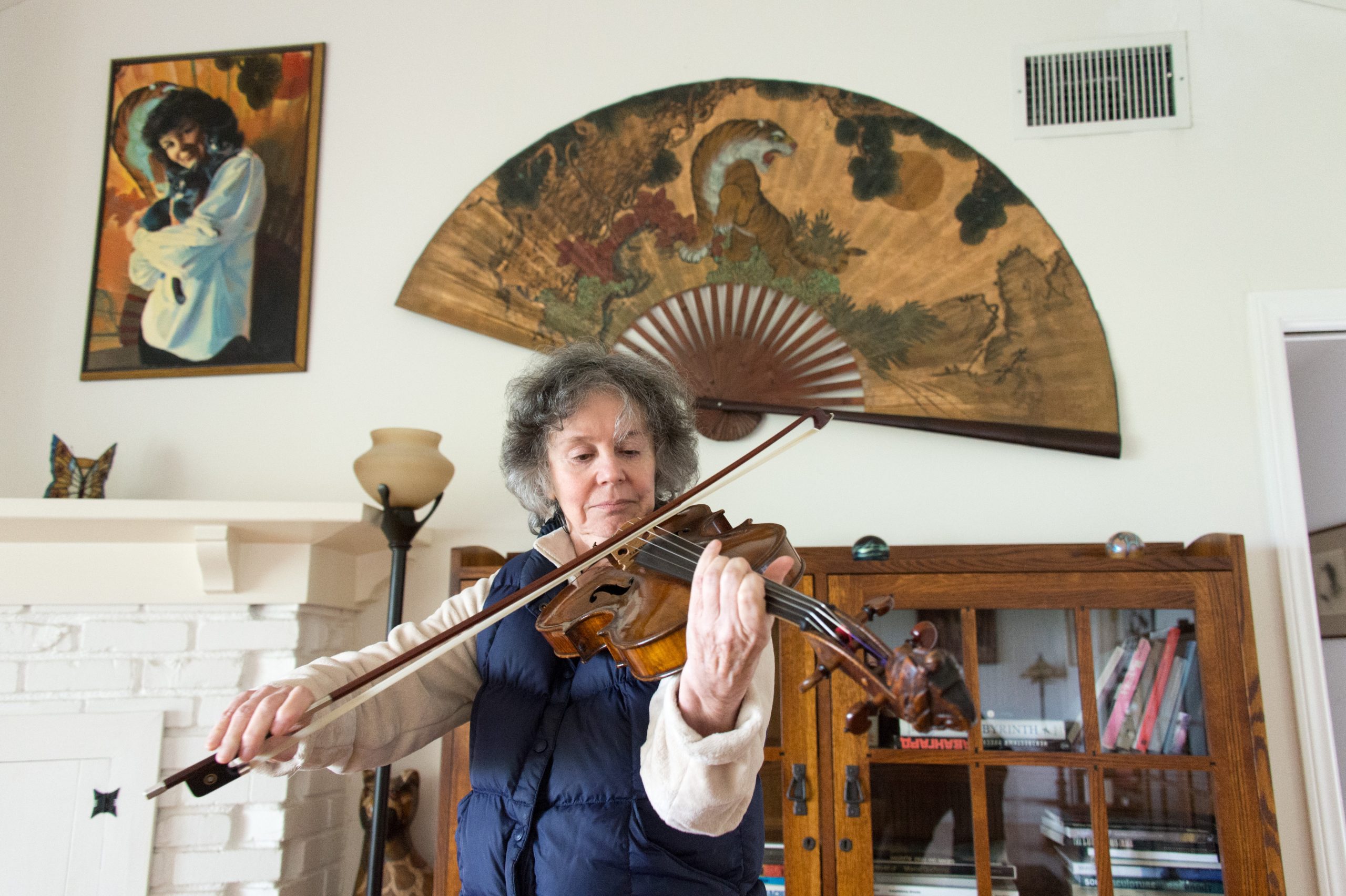Pam Goldsmith, world renowned violist plays her viola from the 1600s.
[NIKON D4, 28.0-300.0 mm f/3.5-5.6, Mode = Aperture Priority, ISO 5600, 1/125, ƒ/4.5, (35mm = 28)]
This is a great clip of the Famous trumpet players Dizzy Gillespie and Louis Armstrong playing together. Listen to the fast sections by Dizzy. This is a great example of muscle memory.
Dizzy Gillespie was the king of the lightning fast riffs of Bebop. No one ever thought of playing the trumpet the way he did. Not even Louis Armstrong played as fast and complex as Gillespie.
I studied trumpet from elementary school through college. I never could play the trumpet like Dizzy Gillespie. What I do know from playing all these years are how to train myself to play music took practice until I could play things using muscle memory.
Muscle memory isn’t something stored in your muscle but your brain. It is a form of procedural memory where practicing something over and over slowly and then as you pick up the speed can then perform something quickly.
 |
| Stanley in traction for a month to help with broken neck. |
 |
| Here I am in the body cast that I would be in for 8 weeks. That made learning to walk even more difficult. |
Another thing about muscle memory is if you don’t use it you can loose it. When I was in third grade I broke my neck. They put me in the hospital for a month in traction. After getting a body cast they had me try and stand. I had to have help.
For the next few days I had to learn how to walk again.
Professionals continue to keep their skills at the highest level so when they need to perform, the muscle memory can kick in and help them tackle the most difficult things thrown at them.
Professional photographers need to take on projects that they can move at slower paces to help keep those muscle memories sharp and accurate. If you practice over and over the wrong way to do something then when you tap into your muscle memory you will perform poorly.
One of the best things I have learned to help me stay sharp is shooting photo stories on my own time. It maybe me shooting a self assigned project or taking on an assignment that gives me the luxury of time verses a quick deadline.
The best things to work on are those that I can shoot edit and then have time to go back and fill in the holes.
Early on in my career I practiced shooting with feature stories. Some of these features would be on a person who had a large collection. I could shoot the photos looking for the seven things I outlined in an earlier post on “Variety the spice of life.”
 |
| Today I find I need more of these type of detail shots to help round out a multimedia package than I did in the printed story. |
When I started producing multimedia packages I soon realized I needed even more images. Why? Audio drives the multimedia package. If you have an interview you want the images to compliment the audio. Sometimes you want to show some of what they are talking about and then sometimes you just need another image so as to help keep the story moving.
With multimedia you use transition images more than you do in a printed story. This is where photos showing transition from one part of the story to another might be helped with a visual. Sometimes the audio has a background noise that having an image of this will help the audience where not including the photo makes the background noise more annoying. Example of this might be hearing of a screen door opening and closing to a country store. You can hear that in the background of the interview of the storeowner. I would include a shot showing someone coming in through the screen door to help resolve this sound for the audience. You don’t need a photo for every time you hear it, but having one will help the story move along.
Why?
Why take stories that you can work on for longer periods of time? This is how you develop that muscle memory for the fast moving deadline story. You need to take things slow and do them right over and over before you can make this part of muscle memory.
Why do this over and over through your career? Don’t you learn how to do this once and you know it?
Just as I forgot how to walk due to inactivity, so too will your storytelling abilities go to atrophy if you do not continue to tell stories.
| This is a project I worked on in Mexico on coffee growers. I was able to take my time and like the results. |
I watched my mentor Don Rutledge come back from overseas story coverage’s for his staff job and then go out the following week and shoot some stories for syndication through Black Star. I often went with him to watch and learn. Some of those stories didn’t have endings. Because we were able if necessary to go back and fill things in since these were more evergreen stories we could talk about what was missing. What I learned is sometimes a story doesn’t fit the classic beginning, middle and end.
Are you working on stories that you can take slowly and be sure all the elements are there on a regular basis, or are you just shooting the assignments given to you on deadline?
Put on your calendar some self-assignments if necessary for you to slow down and take the story at a slower pace so you can practice the art of storytelling. As we all know practice makes perfect.


